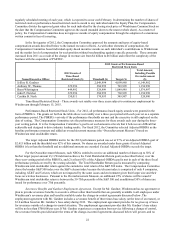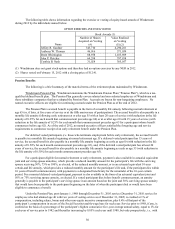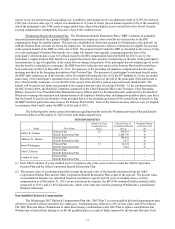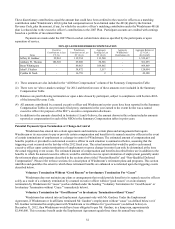Windstream 2012 Annual Report Download - page 29
Download and view the complete annual report
Please find page 29 of the 2012 Windstream annual report below. You can navigate through the pages in the report by either clicking on the pages listed below, or by using the keyword search tool below to find specific information within the annual report.severance is available under the employment agreement in such circumstance. The Compensation Committee approved the
foregoing severance benefit to Mr. Gardner to recognize the importance of his service and contributions to Windstream, to
recognize that it would be difficult for him to find comparable employment during a short period of time following a
separation, and to reflect market practice of providing similar severance benefits to the CEO position.
Retirement Plans. Windstream maintains a defined benefit pension plan and a qualified 401(k) defined contribution
plan for its executive officers (including the NEOs) and employees. Participation in the pension plan is frozen except for
certain bargaining unit employees. No executive officer is eligible for continued accruals. Windstream’s 401(k) plan
provides for potential matching employer contributions of up to 4% of a participant’s compensation. The Compensation
Committee maintains the 401(k) plan in order to provide employees with an opportunity to save for retirement with pre-tax
dollars. The 401(k) plan also allows Windstream to fund its contributions to this plan in a predictable, consistent manner.
Deferred Compensation Plans. Windstream’s 2007 Deferred Compensation Plan provides a non-qualified deferred
compensation plan for its executive officers (including the NEOs) and other key employees. The Compensation Committee
adopted this plan as part of its effort to provide a total compensation package that was competitive with the compensation
arrangements of other companies. The plan offers participants the ability to defer compensation above the IRS qualified plan
limits.
Change-In-Control Agreements. The Compensation Committee maintains change-in-control agreements for
Mr. Gardner and each executive officer (including the NEOs) in order to provide some protection to those individuals from
the risk and uncertainty associated with a potential change-in-control. The Compensation Committee also maintains the
change-in-control agreements as part of its efforts to provide a total compensation package that is competitive with the
compensation arrangements of other market participants.
The change-in-control agreements in place during 2012 expired on January 1, 2013. The Compensation Committee
specifically engaged PM&P to review the payment multiples and other terms of the change-in-control agreements, to
compare such provisions against prevailing market practices, and to provide recommendations on the final terms of the
agreements. When it approved the change-in-control agreements, the Compensation Committee considered the total amount
of compensation that Mr. Gardner and each other executive officer would receive in a hypothetical termination under all of
the change-in-control benefits described below. Based on the foregoing, the Compensation Committee approved the payment
of change-in-control benefits to Mr. Gardner and the other executive officers on a “double-trigger” basis, which means that a
change-in-control of Windstream must occur and the officer’s employment with Windstream must be terminated through
either a resignation for “good reason” or a termination without “cause” (as those terms are defined in the change-in-control
agreement). As a result, Windstream entered into new change-in-control agreements with its NEOs effective January 1, 2013.
The terms of the new change-in-control agreements are generally the same as the prior agreements, except that the new
agreements do not provide for a gross-up payment to any NEOs to offset any excise taxes that may be imposed on excess
parachute payments under Section 4999 of the Internal Revenue Code. Instead, under the change-in-control agreements if
such excise taxes would be imposed, the executive will either receive all of the benefits to which he or she is entitled under
the agreement, subject to the excise tax, or have his or her benefits under the agreement reduced to a level at which the excise
tax will not apply, depending upon which approach would provide the executive with the greater net after-tax benefit. Upon a
qualifying separation from service, the executive officers are eligible to receive a cash, lump sum payment based upon a
multiple of base salary and target bonus of three times for Messrs. Gardner, Thomas, Whittington, and Fletcher and two times
for Ms. Nash. Refer to the “Potential Payment Upon Termination or Change-in-Control” section for details associated with
the Change-in-Control Agreement.
Perquisites and Other Benefits. Windstream permits limited personal use of Windstream's corporate aircraft by Mr.
Gardner and the other named executive officers. Under Windstream's policy, this use cannot interfere with business use of
the aircraft. Due to the extensive travel demands on their schedules, Messrs. Gardner and Whittington are allowed to utilize
the corporate aircraft for personal use more often than the other named executive officers, pursuant to time-sharing
arrangements in which they reimburse Windstream for the incremental cost of such use, which primarily includes costs for
fuel, maintenance charges allocable to such use and contract-pilot charges, and excludes depreciation of the aircraft, general
maintenance, compensation of Windstream's employee pilots, and other general charges related to ownership of the aircraft.
Other named executive officers are allowed to have family members accompany them on a business trip on the aircraft,
subject to seat availability and prior approval of Mr. Gardner. Any other personal use of the aircraft by the other named
executive officers is permitted only as approved in advance by Mr. Gardner. The Compensation Committee monitors the use
by Mr. Gardner and all named executive officers to ensure the amount of usage is reasonable. Windstream believes that
personal use of aircraft for Mr. Gardner and other senior executives is a reasonable benefit in light of the significant demands
that are imposed on their schedules as a result of their responsibilities to Windstream.
23
























